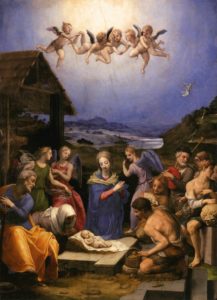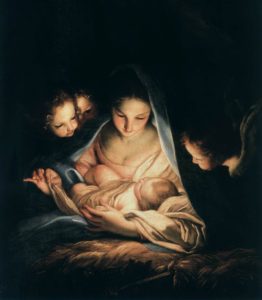 O Holy night! Yes, a silent night! And it came upon a midnight clear! Christmas, it would seem, is a festival of the middle of the night. Jesus is born when it is dark, dark midnight. We are sure of it. And why shouldn’t we be?
O Holy night! Yes, a silent night! And it came upon a midnight clear! Christmas, it would seem, is a festival of the middle of the night. Jesus is born when it is dark, dark midnight. We are sure of it. And why shouldn’t we be?
Even though we are not told the exact hour of His birth, we are sure it must have been at night. Scripture does say that the Shepherds who heard the glad tidings were keeping watch over their flock “by night” (cf Luke 2:9). Further, the Magi sought Him by the light of a star, and stars are seen at night, deep midnight. None of this is evidence that Jesus was born at 12:00 midnight but it sets our clocks for night, deep midnight.
Add to this the fact that Christmas is celebrated at the winter solstice, the very darkest time of the year in the northern hemisphere. More specifically, Christmas comes when light is just beginning its subtle return. The darkest and shortest days of the year occur around December 21st and 22nd. But by December 23rd and 24th we notice a definite but subtle trend: the days are getting longer; the light is returning! It’s time to celebrate the return of the light. It’s going to be all right!
How fitting it is to celebrate the birth of Jesus, the true Light of the World, in deep and dark December. Jesus our light kindles a fire that never dies away. Indeed, in the dark hours of December, we notice a trend: the light is returning; the darkness is abating; the days are beginning to grow longer. It is subtle right now, but it will grow. And with the return of light, we celebrate our True Light: Jesus.
But light is best appreciated in contrast. We appreciate most the glory of light when the darkness assails us. There’s just something about Christmas Eve. As the time approaches through December and the darkness grows, we light lights. Yes, all through December we light Advent candles, more candles as it grows darker. Even the secular among us string up lights, in malls, on their houses, in their workplace. It’s as if to say, the darkness cannot win; the light conquers!
Lights show their true glory when contrasted with darkness. Who sees the stars in the middle of the day? Who appreciates the full beauty of light until he has experienced darkness? Yes, Christmas is a feast of the light. We confront the darkness of December and declare to it, “Your deepest days are over. The light is returning.” And we of faith say to a world in ever deeper darkness, “Your darkness cannot prevail. It will be overcome and replaced.” For although darkness has its season, it is always conquered by the light.
An atheist recently scoffed at me in the comments of this blog that our day is over; the world has rejected faith. Sorry, dear atheist friend, the light always wins. On December 22nd, the darkness begins to recede and the light begins to return. The light returns subtly at first, but it always does; the darkness cannot last.
Light has a way of simply replacing the darkness. In three months the equinox occurs and in six months the summer solstice, when we have the most light. Then the darkness will once again seek to conquer. But it always loses! The light will return. Jesus is always born at the hour of darkness’ greatest moment. Just when the darkness is celebrating most, its hour is over; the light dawns again.
We celebrate after sundown on December 24th, in accordance with a tradition going back to Jewish times (feasts begin at sundown the night before). Christmas morning is almost an afterthought. Most pastors know that the majority of their people come to Mass the “night before.” In a deep and dark December, a light comes forth. A star shines in the heavens.
We gather together in and on a dark night. We smile. We are moved by the cry of a small infant, by whose voice the heavens were made.
 His little cry lights up the night. The darkness must go; the light has come; day is at hand.
His little cry lights up the night. The darkness must go; the light has come; day is at hand.
We celebrate at night so as to bid farewell to the darkness. It cannot prevail. It is destined to be scattered by a Light far more powerful than it is, a Light it must obey, a Light that overwhelms and replaces it. Farewell to darkness; the Light of the World has come!
Jesus is the Light of the World.
The video below is a celebration of light. As a Christmas gift to myself I took the afternoon of December 22nd (the darkest day of the year) off so that I could photograph the triumph of light over darkness. I went to a mausoleum, a place where thousands are buried in the walls. But also in those walls are windows, glorious windows where light breaks through and Christ shines forth. Some of the most beautiful stained glass in the city of Washington, D.C. resides in that place of death and darkness. The light breaks through and it speaks of Christ.
This video shows only some of those stained glass windows (I am putting together a video of other windows to be shown later). The text of the music in this video is from Taizé, and it says, Christe lux mundi, qui sequitur te, habebit lumen vitae, lumen vitae (Christ, Light of the World, who follows you has the light of life, the light of life).
As you view this video depicting the Life of Christ, ponder that although stained glass begins as opaque sand, when subjected to and purified by fire it radiates the glory of the light which can now shine through it. So it is for us. Born in darkness but purified by Christ and the fire of the Spirit, we begin to radiate His many splendored Light shining through us to a dark world.
The Light wins. He always wins.


Thankyou Monsignor, these windows are truly beautiful! I enjoyed watching your video very much. These windows are also instructional depicting the corporal works of mercy. Scenes from Christs’ Life also being depicted especially various Mysteries of the Most Holy Rosary, and various Saints for our inspiration. Many of these windows would be worth meditating upon. What a joy for you to be able to visit and see these beautiful windows – inspiring and uplifting regardless of the “setting”. Thankyou again for sharing these with us your readers.
Thank you so much Father ! I can see how stained-glass, paintings and so on have ‘taught’ the Gospels. When I am exhausted, and cannot read, and cannot pray with words: I have a very few books that I can look at that do my thinking and praying for me…no doubt images such as these touch our brains and hearts, very immediately due to the sensitivity of ‘the eye’ – so rapidly reaching our souls.
the windows you show us are like Icons aren’t they. even better, to me, because, as you write, they depend upon The Son to be seen.
Regarding Our Lord being born at night, altho the the Haydock Bible says the following verses can also be applied to Our Lord’s birth:
Wisdom 18:14-15 ” For while all things were in quiet silence, and the night was in the midst of her course, Thy Almighty word leapt down from heaven from thy royal throne, as a fierce conqueror into the midst of the land of destruction,
Thank you for your article Monsignor Pope. I enjoyed it very much. One thing I would like to comment on. You said that Christmas morning is almost an afterthought and I can’t agree with you more. Yes most people come to Mass on Christmas Eve. However Jesus Christ wasn’t born on Christmas Eve, he was born on Christmas. You even wrote that he was born at dark, dark Midnight. Not 4:00 p.m. Dec 24th, not 6:00 p.m., not even 10:30 p.m. He was born on Dec. 25th. I am all for the Mass at Midnight (the darkest hour), but to have all these Mass’s before hand I feel is a shame. Let’s get God “out of the way” so we can sleep in, open our gifts and not worry about going to church to celebrate the Word Incarnate come into our lives. Sleep and gifts are much more important! When there are more Mass’s on Christmas Eve than on Christmas is truly a tragedy. We don’t even have Midnight Mass in the majority of parishes in our diocese (much too late, let’s have it at 10:30). Let’s get back to celebrating Christmas on Christmas. Let’s at least celebrate light destroying darkness when it’s dark and then after.